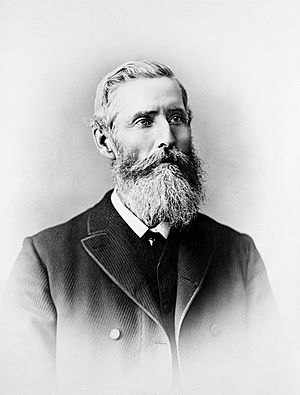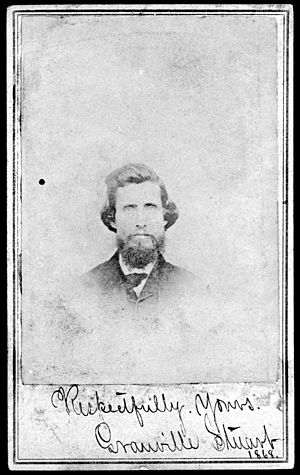Granville Stuart facts for kids
Quick facts for kids
Granville Stuart
|
|
|---|---|

Granville Stuart in 1883
|
|
| Born | August 27, 1834 Harrison County, Virginia, USA
|
| Died | October 2, 1918 (aged 84) |
| Resting place | Deer Lodge, Montana, US |
| Other names | Mr. Montana |
| Occupation | Pioneer, gold prospector, businessman, civic leader, vigilante, author, cattleman and diplomat |
| Political party | Democrat |
| Spouse(s) | Awbonnie Tookanka (1862–1888), Allis Belle Brown (1890–1918) |
| Children | 11 |
Granville Stuart (born August 27, 1834 – died October 2, 1918) was a very important person in the early history of Montana. He was known as "Mr. Montana" because he lived through the time Montana was becoming a territory and then a state. Granville was a pioneer, someone who explored and settled new lands. He also searched for gold, ran businesses, led his community, wrote books, raised cattle, and worked as a diplomat for the United States. His stories and notes have helped historians understand what life was like in the Rocky Mountains in the late 1800s.
Contents
Early Life and Adventures
Granville Stuart was born on August 27, 1834, in Harrison County, Virginia. This area later became part of West Virginia. He was the second son of Robert and Nancy C. Stuart. His older brother was James Stuart. In 1838, Granville's family moved to Muscatine County, Iowa. Growing up in Iowa, Granville and James learned how to hunt, explore, and respect the wild outdoors.
Searching for Gold in California
In 1849, Granville's father, Robert, went to California to look for gold during the California Gold Rush. He didn't find much and returned home in 1851. In 1852, Granville and James went with their father back to California on the Oregon Trail. By 1853, their father went back to Iowa, but the brothers stayed to try and make their own way.
They searched for gold in the Sacramento, California area, then in Yreka in 1854, and the Klamath River valley in 1855. Because of conflicts with Native American tribes in northern California, Granville and James joined the First California Mounted Riflemen in 1856. They worked as scouts for about a month, but didn't encounter any hostile groups. They went back to gold prospecting, but by 1857, they decided to return to their family in Iowa.
Journey to Montana
On their way back east, Granville became very sick in southern Idaho. James stayed with him while the others continued their journey. By the time Granville felt better, it was too late in the year to cross the Rocky Mountains. They couldn't stay in southern Idaho, and they couldn't go to Salt Lake City because of a conflict between the United States and the Mormons.
Instead, they met a former fur trapper named Jake Meek. He was spending the winter with his small group of cattle in the Beaverhead Valley. On October 10, 1857, Granville and James Stuart, along with Jake Meek, traveled north into the Beaverhead Valley. This area would later become part of Montana Territory in 1864. They set up a camp near the Beaverhead River, close to where Dillon, Montana is today. Other traders were already in the valley, often trading healthy cows for tired ones from the Oregon Trail.
For three years, the Stuart brothers traded cattle, horses, and other goods. In 1860, they decided to move north into the Deer Lodge Valley. They set up a camp on Gold Creek, where gold had been found before. In 1858, the Stuarts and their friend Reece Anderson found enough gold on Gold Creek to make them want to return.
Settling in Deer Lodge
In 1861, the Stuarts decided to live permanently in the Deer Lodge Valley. This area was near the Clark Fork River and the Mullan Road, which helped them get supplies from Fort Benton to the east and Walla Walla to the west. They built a small cabin on Gold Creek. Many other gold seekers came to the Deer Lodge Valley in the early 1860s.
With the discovery of gold in Alder Gulch in 1863, most people, including the Stuarts, moved south to Virginia City. However, the Stuarts wanted to keep a presence in Deer Lodge. In 1864, James Stuart helped create a town company. They hired Colonel Walter W. deLacy to plan and map out a proper town on Cottonwood Creek. This town was named Deer Lodge, Montana.
Montana Gold Fields
In 1863, new gold discoveries at Grasshopper Creek attracted many prospectors. The Stuarts moved to Bannack, Montana, to take advantage of the excitement. In Bannack, Granville ran a butcher shop, selling meat to the miners. While there, he met Samuel Hauser and other important Montana pioneers who became his friends and business partners.
Community Leader and Author
Granville Stuart held many public jobs throughout his life. He was the president of the Deer Lodge Town Committee and chairman of the Deer Lodge County Commission. He also served as a trustee for several school districts, the College of Montana (Montana's first college), and the Montana Territorial Prison. He was elected to the Montana Territorial Legislative Assembly five times. In the 1890s, he worked as a state land agent. From 1905 to 1914, he was the head librarian at the Butte Public Library. He also helped start the Society of Montana Pioneers in 1884 and was its president in 1886.
Granville Stuart loved to write. From a young age, he kept detailed notes, diaries, and journals. He also saved copies of most of his letters. Many of these writings are still kept today by the Montana Historical Society, which he helped create in 1864. He wrote several books about Montana and its early history. His writings are considered very important for understanding the history of the western United States.
Books by Granville Stuart
- Montana As It Is-Being a General description of its Resources, both Mineral and Agricultural (1865)
- Forty Years On the Frontier as seen in the Journals and Reminiscences of Granville Stuart, gold-miner, trader, merchant, rancher and politician (1925)
- Pioneering in Montana-The Making of a State, 1864–1887 (1977) (This is a reprint of part of Forty Years on the Frontier)
- Diary and Sketchbook of a Journey to "America" in 1866 and Return Trip up the Missouri River to Fort Benton, Montana (1963)
Cattle Rancher
In 1879, Granville Stuart was working as a bookkeeper for his friend Samuel T. Hauser's bank in Helena, Montana. Stuart knew that the cattle business was growing fast on the open plains. He encouraged Hauser to get involved. Hauser, along with another banker, Andrew J. Davis, started the Davis, Hauser and Stuart (DHS) cattle company. Stuart was a smaller partner, borrowing money from Hauser for his share. Davis and Hauser made Stuart the general manager of the DHS ranch.
In 1879 and 1880, Stuart bought about 9,400 cattle. By July 1879, he had found a good location for the DHS ranch on 800 acres near the Judith Range, close to Lewistown, Montana. The ranch was near Fort Maginnis, which offered some protection and a place to sell cattle.
In 1884, Granville Stuart became known as the leader of a group of ranchers who took action against horse thieves and cattle rustlers. These groups were sometimes called "vigilantes." In 1885, Granville Stuart was elected president of the Montana Stockgrowers Association, a group for cattle ranchers.
Granville and his first wife, Awbonnie, built a good life on the DHS ranch with their children. However, their financial luck changed during the very cold Winter of 1886–1887. Too many cattle on the open range, a dry summer, and a harsh winter caused a disaster. By April 1887, the DHS ranch had lost about 60% of its 40,000 cattle. The ranch never fully recovered. Granville left the ranch in 1890.
Diplomat for the United States
Granville Stuart had a long friendship with Samuel Hauser, who had been a governor of Montana Territory and had strong connections with the Democratic Party. In 1893, Hauser helped Granville get a job with the government. In 1894, at 60 years old, Granville Stuart was appointed as a diplomat, called a Minister Plenipotentiary, to Uruguay and Paraguay.
On August 25, 1897, Stuart was with Uruguayan president Juan Idiarte Borda when the president was assassinated during an Independence Day parade in Montevideo.
Family Life
On April 15, 1862, Granville, at age 27, married a twelve-year-old Shoshone Native American girl named Awbonnie Tookanka. Awbonnie and Granville had eleven children together: Kate, Tom, Charlie, Mary, Elizabeth, Emma, George, Eddie, Harry, Sam, and Irene. Sadly, Emma and George died when they were babies. Awbonnie and Granville were married until she passed away in 1888 at age 41 due to an illness after childbirth.
On January 8, 1890, Granville married twenty-six-year-old Allis Belle Brown. She had been his children's teacher at the DHS ranch. Allis encouraged Granville to send his Shoshone children to the local St. Ignatius Mission. Allis and Granville did not have any children of their own. Allis Belle lived longer than Granville, passing away in Hamilton, Montana, in 1947.
Granville and his brother James were very close and worked together on most things. They were rarely apart until January 1871, when James left Deer Lodge to run a trading business at a government post. James left his wife and three sons with Granville and Awbonnie. In 1873, James became ill and passed away. Granville brought his brother's body back to Deer Lodge, where he was buried on November 5, 1873.
Later Years and Passing
When Granville returned to Montana from South America, he didn't have many job opportunities. A new government was in power in Washington, D.C., so there were no more federal appointments for him. Stuart hadn't become rich during his more than 40 years in Montana and still had some debts.
Granville and Belle settled in Butte, Montana. In 1905, his good friend, William A. Clark, helped him get a job as the head librarian for the Butte Public Library. He worked there until 1914. For a while, the Stuarts also ran a boarding house in Butte. During his time in Butte, Stuart put together most of the writings that would be published as Forty Years on the Frontier in 1925.
In 1915–1917, Montana participated in an event called the Panama–California Exposition in San Diego, California. William Clark had given money to build "The Montana Building" there. Clark insisted that Granville Stuart be chosen to represent Montana at the Exposition, which he did for its first year.
In 1917, Belle and Granville moved to Missoula, Montana. Granville continued to work on his life story and a history of Montana pioneers that was never published. His health was failing. His last public appearance was in September 1918 at a meeting of the Montana Pioneers Society. On the morning of October 2, 1918, "Mr. Montana," Granville Stuart, passed away from heart failure at his home. His funeral was held in Deer Lodge, Montana, on October 6, 1918. He is buried in Deer Lodge, next to his brother James Stuart.
Legacy
Granville Stuart was honored in 2008 as a Legacy Inductee into the Montana Cowboy Hall of Fame in Big Timber, Montana. There is an elementary school named after him in Deer Lodge. A ship, the S.S. Granville Stuart, was named in his honor and launched on July 11, 1943. In 1966, he was added to the Hall of Great Westerners at the National Cowboy & Western Heritage Museum.
Images for kids




